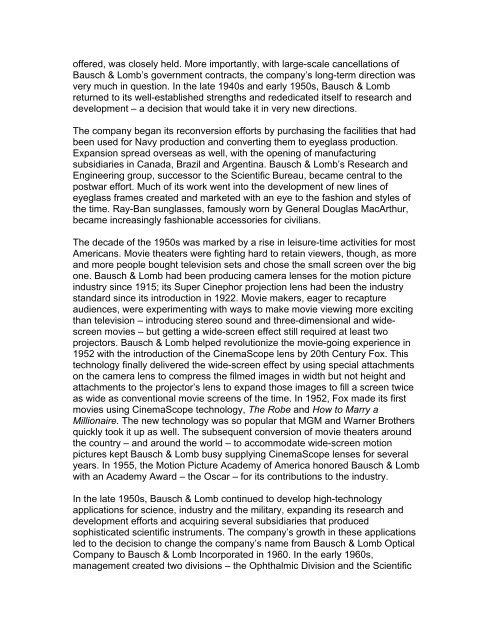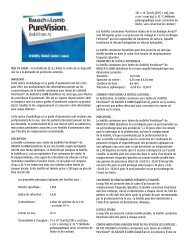Bausch & Lomb Perfecting vision, enhancing life for 150 years A ...
Bausch & Lomb Perfecting vision, enhancing life for 150 years A ...
Bausch & Lomb Perfecting vision, enhancing life for 150 years A ...
Create successful ePaper yourself
Turn your PDF publications into a flip-book with our unique Google optimized e-Paper software.
offered, was closely held. More importantly, with large-scale cancellations of<br />
<strong>Bausch</strong> & <strong>Lomb</strong>’s government contracts, the company’s long-term direction was<br />
very much in question. In the late 1940s and early 1950s, <strong>Bausch</strong> & <strong>Lomb</strong><br />
returned to its well-established strengths and rededicated itself to research and<br />
development – a decision that would take it in very new directions.<br />
The company began its reconversion ef<strong>for</strong>ts by purchasing the facilities that had<br />
been used <strong>for</strong> Navy production and converting them to eyeglass production.<br />
Expansion spread overseas as well, with the opening of manufacturing<br />
subsidiaries in Canada, Brazil and Argentina. <strong>Bausch</strong> & <strong>Lomb</strong>’s Research and<br />
Engineering group, successor to the Scientific Bureau, became central to the<br />
postwar ef<strong>for</strong>t. Much of its work went into the development of new lines of<br />
eyeglass frames created and marketed with an eye to the fashion and styles of<br />
the time. Ray-Ban sunglasses, famously worn by General Douglas MacArthur,<br />
became increasingly fashionable accessories <strong>for</strong> civilians.<br />
The decade of the 1950s was marked by a rise in leisure-time activities <strong>for</strong> most<br />
Americans. Movie theaters were fighting hard to retain viewers, though, as more<br />
and more people bought tele<strong>vision</strong> sets and chose the small screen over the big<br />
one. <strong>Bausch</strong> & <strong>Lomb</strong> had been producing camera lenses <strong>for</strong> the motion picture<br />
industry since 1915; its Super Cinephor projection lens had been the industry<br />
standard since its introduction in 1922. Movie makers, eager to recapture<br />
audiences, were experimenting with ways to make movie viewing more exciting<br />
than tele<strong>vision</strong> – introducing stereo sound and three-dimensional and widescreen<br />
movies – but getting a wide-screen effect still required at least two<br />
projectors. <strong>Bausch</strong> & <strong>Lomb</strong> helped revolutionize the movie-going experience in<br />
1952 with the introduction of the CinemaScope lens by 20th Century Fox. This<br />
technology finally delivered the wide-screen effect by using special attachments<br />
on the camera lens to compress the filmed images in width but not height and<br />
attachments to the projector’s lens to expand those images to fill a screen twice<br />
as wide as conventional movie screens of the time. In 1952, Fox made its first<br />
movies using CinemaScope technology, The Robe and How to Marry a<br />
Millionaire. The new technology was so popular that MGM and Warner Brothers<br />
quickly took it up as well. The subsequent conversion of movie theaters around<br />
the country – and around the world – to accommodate wide-screen motion<br />
pictures kept <strong>Bausch</strong> & <strong>Lomb</strong> busy supplying CinemaScope lenses <strong>for</strong> several<br />
<strong>years</strong>. In 1955, the Motion Picture Academy of America honored <strong>Bausch</strong> & <strong>Lomb</strong><br />
with an Academy Award – the Oscar – <strong>for</strong> its contributions to the industry.<br />
In the late 1950s, <strong>Bausch</strong> & <strong>Lomb</strong> continued to develop high-technology<br />
applications <strong>for</strong> science, industry and the military, expanding its research and<br />
development ef<strong>for</strong>ts and acquiring several subsidiaries that produced<br />
sophisticated scientific instruments. The company’s growth in these applications<br />
led to the decision to change the company’s name from <strong>Bausch</strong> & <strong>Lomb</strong> Optical<br />
Company to <strong>Bausch</strong> & <strong>Lomb</strong> Incorporated in 1960. In the early 1960s,<br />
management created two di<strong>vision</strong>s – the Ophthalmic Di<strong>vision</strong> and the Scientific






